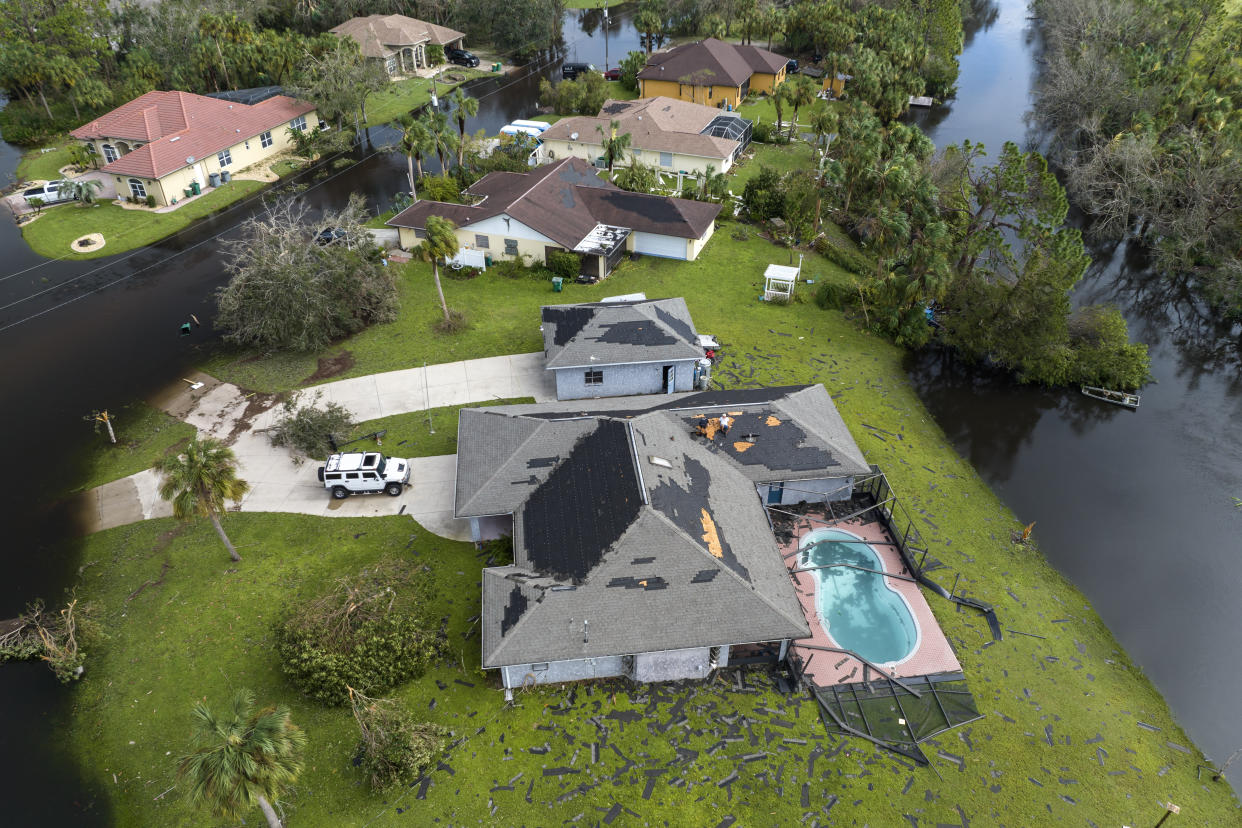4 reasons why U.S. home insurance is suddenly skyrocketing (Hint: It's not just climate change)

Homeowners insurance rates are rising fast. Very fast.
In 2023, home insurance premiums increased by an average of 11.3%, according to S&P Global Market Intelligence. Although St. Louis Federal Reserve data shows the rise has tapered off, rates are still higher than expected based on the past 15 years of premium trends.
So what gives? Why do rates keep climbing?
Douglas Heller, Director of Insurance at the Consumer Federation of America, a national consumer advocacy organization, says there are four big reasons why Americans will continue to pay high premiums.
Recommended reading from Yahoo: U.S. housing market, economy at serious risk due to $3 trillion in uninsured homes
1. Climate change and extreme weather
Human-driven climate change and the associated increase in extreme weather events are the leading drivers of increased insurance premiums, according to Heller. The rising number of destructive weather disasters means insurance companies take on more risk by insuring homes.
According to the National Centers for Environmental Information, the number of weather- and climate-related disasters that cause over $1 billion in losses has risen consistently since the 1980s. There were an average of 3.3 events per year from 1980 to 1989. In 2021 through 2023, there were 22 events per year on average. As of August 8, 2024, we'd already seen 19 $1 billion weather or climate disasters with nearly six months left in the year. The chart below provides more specifics
Years | $1 billion disasters | Events per year |
|---|---|---|
1980s (1980 to 1989) | 33 | 3.3 |
1990s (1990 to 1999) | 57 | 5.7 |
2000s (2000 to 2009) | 67 | 6.7 |
2010s (2010 to 2019) | 131 | 13.1 |
Last five years (2019 to 2023) | 102 | 20.4 |
Last three years (2021 to 2023) | 66 | 22 |
Last year (2023) | 28 | 28 |
Data source: National Centers for Environmental Information (2024).
Not all these $1 billion events are tropical hurricanes and Western wildfires. In fact, severe storms made up over half of the $1 billion in weather disasters since 1980. And, according to Climate Central, those storms are becoming more common in high-risk areas, including those with denser populations and a higher concentration of mobile homes.
Droughts and freezes can cost billions of dollars in damages, too, and every state in the continental U.S. has seen at least one of these $1 billion disasters during the past 15 years.
Home insurance providers haven't effectively predicted the risk, leading to profit losses in the last decade, according to Paul Anderson and Jonathan Glowacki, two actuaries at Milliman, a consulting firm that works with global insurance companies. When asked about rising premiums, Anderson said, "[F]or the past 7 years, the premium collected for homeowners insurance has been less than the amount paid for claims." The result? Rising premiums.
The associated risks apparently aren't shared equitably, either; research suggests homes in relatively safer areas of the country also see higher premiums. Despite paying out more than they collected in premiums, the property and casualty insurance industry still pulled in over $87 billion in income in 2023, according to data from the National Association of Insurance Commissioners (NAIC).
2. Reinsurance costs and investment profits
Home insurance providers don't assume all risk when they insure a home. Instead, they offload some of it to reinsurers, or large companies that essentially provide insurance to insurance companies. Those reinsurers are changing how they do business.
Reinsurers posted increased profits over the past year, according to Insurance Business Magazine, and those profits come partially from price increases. As reinsurers evaluate their exposure to climate-related risks, insurers may see increased costs for reinsurance. Those increases can be passed along to consumers to at least some degree, depending on the state those consumers live in.
Reinsurers have also reportedly tweaked their terms and conditions, resulting in those companies paying a smaller share of losses sustained in natural catastrophes. While the Insurance Business Magazine doesn't specify where those shares are made up, it's not a big leap to guess that insurance companies and their customers pay the difference.
https://unsplash.com/photos/a-pile-of-debris-with-a-house-in-the-background-oa_63VHgdiA
Insurance companies also earn much of their profit by investing their premiums before making payouts. According to Macrotrends, a stock research platform, the S&P 500's 2022 loss of 19.44% was the worst since 2008. Heller says companies were motivated to increase premiums to make up for a shortfall in investing revenue.
This combination of increased reinsurance costs and lower investment returns have eaten into insurers' profits, and the Consumer Federation of America's Heller says that's a big part of why premiums have been on the rise.
3. Inflation's effect on home insurance

Another factor influencing the price of insurance premiums is the cost to rebuild a damaged or destroyed home. If the price of repairing a home rises, insurance companies raise rates.
Data from the Federal Reserve Bank of St. Louis shows that building materials experienced notable inflation during the past two years. The price index, which represents how much these supplies cost, increased by about 70% from mid-2020 to the end of 2022, according to that data. However, prices are still higher than expected based on increases over the previous 15 years.
How much does inflation really affect premiums? Heller thinks the cost may be overblown and says insurance companies didn't lower premiums commensurately after the recent inflation scare. This could reflect their increased reinsurance costs, lower investment returns, and poor underwriting results of the past several years.
4. Regulation
An increase in weather- and climate-related disasters, rising reinsurance costs, hits to investment returns, and inflation all affect insurers' profit margins, which results in higher premiums for homeowners. Another factor exists that's harder to quantify: regulation.
Heller believes insurance premiums have gone up because insurance companies threaten legislators by saying they'll stop insuring homes in a given state if they don't get what they want (which is usually an increase in premiums).
Some state legislators are willing to stand up to insurance companies to fight big rate increases – California is a notable example, though there's disagreement over whether the state's regulations have been successful. Regardless, it's harder for insurance to raise rates in California than elsewhere.
So insurance companies respond by raising their rates in other states. States in which regulators don't go as far to protect their constituents from rate increases see notably higher premiums, according to a recent New York Times article. The article detailed the vast discrepancies between home insurance prices around the country, showing that while the national average home insurance premium was about 0.5% per $100,000 of the home's value, some California homeowners were paying 0.05%, and parts of Alabama, Oklahoma, Louisiana, and Texas paid over 2%.
California's rate regulation keeps rates low, while regulation-averse Southern states let insurance companies raise rates to make up for lower premiums elsewhere. To be clear, insurance companies say they don't do this and rates are driven by risk, but a 2022 research paper by researchers Sangmin Oh of Columbia University, Ishita Sen of Harvard University, and the U.S. Federal Reserve Board of Governors' Ana-Maria Tenekedjieva indicates there has been a "decoupling of rates from risks" consistent with this activity.
Complicated confluence of factors causes home insurance increases
Climate change is causing an increase in severely destructive storms which, in turn, increase risk for insurers. Reinsurance companies that serve as backstops for insurers are raising prices and altering their terms. The stock market – part of insurance companies' source of profits – took a big hit in 2022. Costs for building materials are still high due to inflation. Regulations for protecting consumers from exorbitant rate increases vary wildly by state and your risk doesn't determine your insurance premium. Insurance companies are driven to continue growing their billions in profits.
All of those factors influence home insurance rates. So what, if anything, can be done?
Milliman's Anderson and Glowacki suggest homeowners should "ensure their homes are resilient to [extreme weather] events," and the government should encourage them to do so, though they note "there is not a short-term silver bullet." Heller believes lawmakers should stand up to bullying by insurance companies and better protect their constituents from profit-driven rate hikes, as they've done in California.
The recent spike in home insurance rates comes from a complicated combination of factors, and homeowners are largely at the mercy of large corporations. Will U.S. consumers agree to pay for more resilient homes? Or will they demand change at the corporate and legislative levels? If rates continue to increase, we just may find out.


